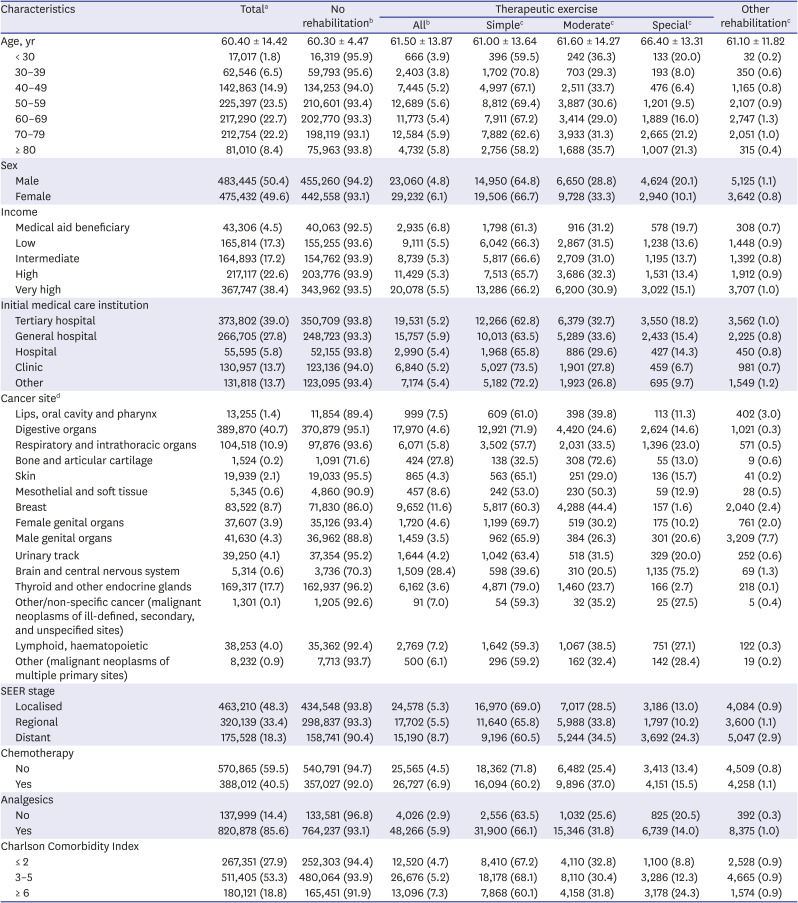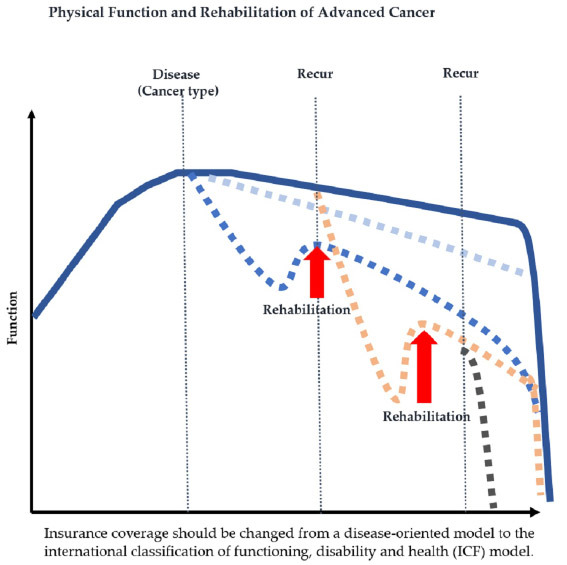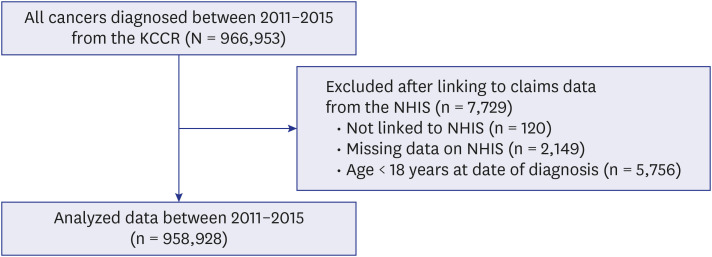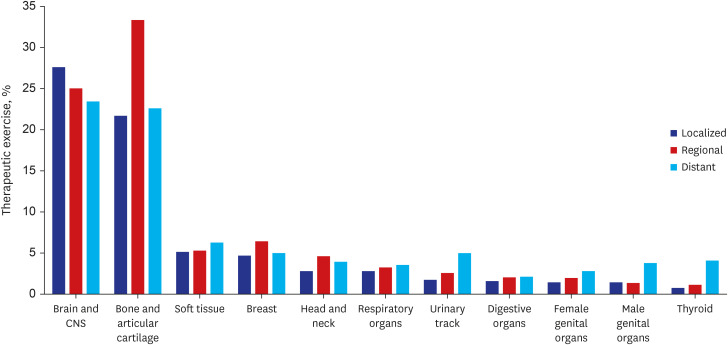1. Gilchrist LS, Galantino ML, Wampler M, Marchese VG, Morris GS, Ness KK. A framework for assessment in oncology rehabilitation. Phys Ther. 2009; 89(3):286–306. PMID:
19147708.

2. Javier NS, Montagnini ML. Rehabilitation of the hospice and palliative care patient. J Palliat Med. 2011; 14(5):638–648. PMID:
21592031.

3. Young-McCaughan S, Arzola SM. Exercise intervention research for patients with cancer on treatment. Semin Oncol Nurs. 2007; 23(4):264–274. PMID:
18022054.

4. Cheville AL, Troxel AB, Basford JR, Kornblith AB. Prevalence and treatment patterns of physical impairments in patients with metastatic breast cancer. J Clin Oncol. 2008; 26(16):2621–2629. PMID:
18509174.

5. Silver JK, Baima J, Mayer RS. Impairment-driven cancer rehabilitation: an essential component of quality care and survivorship. CA Cancer J Clin. 2013; 63(5):295–317. PMID:
23856764.

6. Gupta AD, Lewis S, Shute R. Patients living with cancer - the role of rehabilitation. Aust Fam Physician. 2010; 39(11):844–846. PMID:
21301657.
7. Mewes JC, Steuten LM, Ijzerman MJ, van Harten WH. Effectiveness of multidimensional cancer survivor rehabilitation and cost-effectiveness of cancer rehabilitation in general: a systematic review. Oncologist. 2012; 17(12):1581–1593. PMID:
22982580.

8. Yang J, Choi M, Choi J, Kang M, Jo A, Chung SH, et al. Supervised physical rehabilitation in the treatment of patients with advanced cancer: a systematic review and meta-analysis. J Korean Med Sci. 2020; 35(29):e242. PMID:
32715671.

9. Thorsen L, Gjerset GM, Loge JH, Kiserud CE, Skovlund E, Fløtten T, et al. Cancer patients' needs for rehabilitation services. Acta Oncol. 2011; 50(2):212–222. PMID:
21231783.

10. Park YH, Ko RE, Kang D, Park J, Jeon K, Yang JH, et al. Relationship between use of rehabilitation resources and ICU readmission and ER visits in ICU survivors: the Korean ICU National Data Study 2008-2015. J Korean Med Sci. 2020; 35(15):e101. PMID:
32301293.

11. Yang EJ, Chung SH, Jeon JY, Seo KS, Shin HI, Hwang JH, et al. Current practice and barriers in cancer rehabilitation: perspectives of Korean physiatrists. Cancer Res Treat. 2015; 47(3):370–378. PMID:
25672583.

12. Shin HR, Won YJ, Jung KW, Kong HJ, Yim SH, Lee JK, et al. Nationwide cancer incidence in Korea, 1999~2001; first result using the national cancer incidence database. Cancer Res Treat. 2005; 37(6):325–331. PMID:
19956367.

13. Koh HK, Kim H, Hong S. Patterns of care after surgery for elderly patients with malignant brain tumors: data from the National Health Insurance Service in South Korea. Anticancer Res. 2019; 39(10):5733–5739. PMID:
31570475.

14. Lim SS, Lee W, Kim YK, Kim J, Park JH, Park BR, et al. The cumulative incidence and trends of rare diseases in South Korea: a nationwide study of the administrative data from the National Health Insurance Service database from 2011-2015. Orphanet J Rare Dis. 2019; 14(1):49. PMID:
30777110.

15. Podnos YD, Borneman TR, Koczywas M, Uman G, Ferrell BR. Symptom concerns and resource utilization in patients with lung cancer. J Palliat Med. 2007; 10(4):899–903. PMID:
17803411.

16. Oksbjerg Dalton S, Halgren Olsen M, Moustsen IR, Wedell Andersen C, Vibe-Petersen J, Johansen C. Socioeconomic position, referral and attendance to rehabilitation after a cancer diagnosis: a population-based study in Copenhagen, Denmark 2010-2015. Acta Oncol. 2019; 58(5):730–736. PMID:
30905247.

17. Hellbom M, Bergelt C, Bergenmar M, Gijsen B, Loge JH, Rautalahti M, et al. Cancer rehabilitation: a Nordic and European perspective. Acta Oncol. 2011; 50(2):179–186. PMID:
21231779.

18. Braddom RL. Medicare funding for inpatient rehabilitation: How did we get to this point and what do we do now? Arch Phys Med Rehabil. 2005; 86(7):1287–1292. PMID:
16003652.

19. Kim SW, Jeon HR, Youk T, Kim J. The nature of rehabilitation services provided to children with cerebral palsy: a population-based nationwide study. BMC Health Serv Res. 2019; 19(1):277. PMID:
31046762.

20. Joshy G, Thandrayen J, Koczwara B, Butow P, Laidsaar-Powell R, Rankin N, et al. Disability, psychological distress and quality of life in relation to cancer diagnosis and cancer type: population-based Australian study of 22,505 cancer survivors and 244,000 people without cancer. BMC Med. 2020; 18(1):372. PMID:
33256726.

21. Diehr P, Yanez D, Ash A, Hornbrook M, Lin DY. Methods for analyzing health care utilization and costs. Annu Rev Public Health. 1999; 20(1):125–144. PMID:
10352853.

22. Sagen A, Kåresen R, Sandvik L, Risberg MA. Changes in arm morbidities and health-related quality of life after breast cancer surgery - a five-year follow-up study. Acta Oncol. 2009; 48(8):1111–1118. PMID:
19863218.

23. Yang EJ, Park WB, Seo KS, Kim SW, Heo CY, Lim JY. Longitudinal change of treatment-related upper limb dysfunction and its impact on late dysfunction in breast cancer survivors: a prospective cohort study. J Surg Oncol. 2010; 101(1):84–91. PMID:
19924721.

24. Ewertz M, Jensen AB. Late effects of breast cancer treatment and potentials for rehabilitation. Acta Oncol. 2011; 50(2):187–193. PMID:
21231780.

25. Hamaguchi T, Okamura H, Nakaya N, Abe K, Abe Y, Umezawa S, et al. Survey of the current status of cancer rehabilitation in Japan. Disabil Rehabil. 2008; 30(7):559–564. PMID:
17852319.

26. Movsas SB, Chang VT, Tunkel RS, Shah VV, Ryan LS, Millis SR. Rehabilitation needs of an inpatient medical oncology unit. Arch Phys Med Rehabil. 2003; 84(11):1642–1646. PMID:
14639564.
27. Lehmann JF, DeLisa JA, Warren CG, deLateur BJ, Bryant PL, Nicholson CG. Cancer rehabilitation: assessment of need, development, and evaluation of a model of care. Arch Phys Med Rehabil. 1978; 59(9):410–419. PMID:
687056.
28. Prado CM, Baracos VE, McCargar LJ, Reiman T, Mourtzakis M, Tonkin K, et al. Sarcopenia as a determinant of chemotherapy toxicity and time to tumor progression in metastatic breast cancer patients receiving capecitabine treatment. Clin Cancer Res. 2009; 15(8):2920–2926. PMID:
19351764.

29. Ross PJ, Ashley S, Norton A, Priest K, Waters JS, Eisen T, et al. Do patients with weight loss have a worse outcome when undergoing chemotherapy for lung cancers? Br J Cancer. 2004; 90(10):1905–1911. PMID:
15138470.

30. Yang EJ, Lee KS, Lim MC, Baek JY, Han JY, Yu ES, et al. Symptom perception and functioning in patients with advanced cancer. PLoS One. 2021; 16(2):e0245987. PMID:
33539372.







 PDF
PDF Citation
Citation Print
Print







 XML Download
XML Download